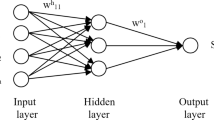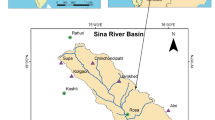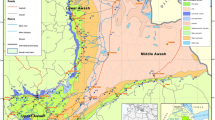Abstract
Drought forecasting is a major component of a drought preparedness and mitigation plan. This paper focuses on an investigation of artificial neural networks (ANN) models for drought forecasting in the algerois basin in Algeria in comparison with traditional stochastic models (ARIMA and SARIMA models). A wavelet pre-processing of input data (wavelet neural networks WANN) was used to improve the accuracy of ANN models for drought forecasting. The standard precipitation index (SPI), at three time scales (SPI-3, SPI-6 and SPI-12), was used as drought quantifying parameter for its multiple advantages. A number of different ANN and WANN models for all SPI have been tested. Moreover, the performance of WANN models was investigated using several mother wavelets including Haar wavelet (db1) and 16 daubechies wavelets (dbn, n varying between 2 and 17). The forecast results of all models were compared using three performance measures (NSE, RMSE and MAE). A comparison has been done between observed data and predictions, the results of this study indicate that the coupled wavelet neural network (WANN) models were the best models for drought forecasting for all SPI time series and over lead times varying between 1 and 6 months. The structure of the model was simplified in the WANN models, which makes them very convenient and parsimonious. The final forecasting models can be utilized for drought early warning.










Similar content being viewed by others
References
Adamowski J, Sun K (2010) Development of a coupled wavelet transform and neural network method for flow forecasting of non-perennial rivers in semi-arid watersheds. J Hydrol 390:85–91
Akaike H (1974) A look at the statistical model identification. IEEE Trans Autom Control AC 19:716–723
ASCE Task Committee on Application of Artificial Neural Networks in Hydrology (2000) Artificial neural networks in hydrology. I. Preliminary concepts. J Hydrol Eng 5(2):124–137
Aussem A, Campbell J, Murtagh F (1998) Wavelet-based feature extraction and decomposition strategies for financial forecasting. J Comput Intel Finan 6(2):5–12
Avilès A, Célleri R, Paredes J, Solera A (2015) Evaluation of Markov chain based drought forecasts in an Andean regulated River Basin using the skill scores RPS and GMSS. Water Resour Manag 29:1949–1963
Belayneh A, Adamowski J (2012) Standard precipitation index drought forecasting using neural networks, wavelet neural networks, and support vector regression. Appl Comput Intell Soft Comput. doi:10.1155/2012/794061
Belayneh A, Adamowski J, Khalil B, Ozga-Zielinski B (2014) Long-term SPI drought forecasting in the Awash River Basin in Ethiopia using wavelet neural networks and wavelet support vector regression models. J Hydrol 508:418–429
Bordi I, Sutera A (2007) Drought monitoring and forecasting at large scale. In: Rossi G (ed) Methods and tools for drought analysis and management. Springer, Dordrecht, pp 3–27
Box GEP, Jenkins GM (1976) Time series analysis, forecasting and control. Holden-Day, San Francisco
Cancelliere A, Di Mauro G, Bonaccorso B, Rossi G (2007) Drought forecasting using the standardized precipitation index. Water Resour Manag 21(5):801–819
Edwards DC, McKee TB (1997) Characteristics of 20th century drought in the United States at multiple time scales. Colorado State University, Fort Collins. Climatology Report No. 97–2, CO
Fernández C, Vega JA, Fonturbel T, Jiménez E (2009) Streamflow drought time series forecasting: a case study in a small watershed in North West Spain. Stoch Env Res Risk A 23:1063–1070
Han P, Wang PX, Zhang SY, Zhu DH (2010) Drought forecasting based on the remote sensing data using ARIMA Models. Math Comput Model 51(11–12):1398–1403
Hayes MJ, Svoboda MD, Wilhite DA, Vanyarkho OV (1999) Monitoring the 1996 drought using the standardized precipitation index. Bull Am Meteorol Soc 80:429–438
Hipel KW, McLeod AI (1994) Time series modelling of water resources and environmental systems. Elsevier, London
Imrie CE, Durucan S, Korre A (2000) River flow prediction using artificial neural networks: generalization beyond the calibration range. J Hydrol 233:138–153
Kim T, Valdes JB (2003) Nonlinear model for drought forecasting based on a conjunction of wavelet transforms and neural networks. J Hydrol Eng 8:319–328
Legates DR, McCabe GJ Jr (1999) Evaluating the use of “goodness-of-fit” measures in hydrologic and hydroclimatic model validation. Water Resour Res 35(1):233–241
Maheswaran R, Khosa R (2012) Comparative study of different wavelets for hydrologic forecasting. Comput Geosci 46:284–295
Marj AF, Meijerink AM (2011) Agricultural drought forecasting using satellite images, climate indices and artificial neural network. Int j Remote Sens 32(24):9707–9719
McKee TB, Doesken NJ, Kleist J (1993) The Relationship of Drought Frequency and Duration to Time Scales. In: Proc. 8th Conf. on Applied Climatology, 17–22 January, Americ Meteorol Soc, Mass, pp 179–184
Medejerab A, Henia L (2011) Variations spatio-temporelles de la sécheresse climatique en Algérie Nord occidentale. Courrier du savoir 11:71–79
Mishra AK, Desai VR (2005) Drought forecasting using stochastic models. Stoch Env Res Risk A 19(5):326–339
Mishra AK, Desai VR (2006) Drought forecasting using feed-forward recursive neural network. Ecol Model 198(1–2):127–138
Mishra AK, Desai VR, Singh VP (2007) Drought forecasting using a hybrid stochastic and neural network model. J Hydrol Eng, 12(6):626–638
Modarres R (2007) Streamflow drought time series forecasting. Stoch Env Res Risk A 15(21):223–233
Morid S, Smakhtin V, Bagherzadeh K (2007) Drought forecasting using artificial neural networks and time series of drought indices. Int J Climatol 27(15):2103–2111
Nalbantis I, Tsakiris G (2009) Assessment of hydrological droughts revisited. Water Resour Manag 23:881–897
Nalley D, Adamowski J, Khalil B (2012) Using discrete wavelet transforms to analyze trends in streamflow and precipitation in Quebec and Ontario (1954–2008). J Hydrol 475(19):204–228
Nourani V, Komasi M, Mano A (2009) A multivariate ANN-wavelet approach for rainfall–runoff modeling. Water Resour Manag 23(14):2877–2894
Nourani V, Kisi O, Komasi M (2011) Two hybrid artificial intelligence approaches for modeling rainfall–runoff process. J Hydrol 402(1–2):41–59
Nourani V, Hosseini Baghanam A, Adamowski J, Kisi O (2014) Applications of hybrid wavelet–Artificial Intelligence models in hydrology: a review. J Hydrol 514:358–377
Özger M, Mishra AK, Singh VP (2012) Long lead time drought forecasting using a wavelet and fuzzy logic combination model: a case study in Texas. J Hydrometeorol 13(1):284–297
Palmer WC (1965) Meteorological drought. Research Paper No. 45. US Weather Bureau, Washington
Paulo AA, Pereira LS (2006) Prediction of SPI drought class transitions using Markov chains. Water Resour Manag 21:1813–1827
Paulo AA, Pereira LS (2007) Stochastic prediction of SPI drought class transition. Water Resour Manag 22:1277–1527
Paulo AA, Pereira LS (2008) Stochastic prediction of drought class transitions. Water Resour Manag 22:1277–1296
Renaud O, Starck J, Murtagh F (2005) Wavelet-based combined signal filtering and prediction. IEEE Trans Syst Man Cybernetics Part B: Cybernetics 35(6):1241–1251
Sang YF (2012) A practical guide to discrete wavelet decomposition of hydrologic time series. Water Resour Manage 26:3345–3365
Sang FY (2013) Improved wavelet modeling framework for hydrologic time series modeling. Water Resour Manag 27:2807–2821
Schwarz G (1978) Estimating the dimension of a model. Ann Stat 6(2):461–464
Shafer BA, Dezman LE (1982) Development of a Surface Water Supply Index (SWSI) to assess the severity of drought conditions in snowpack runoff areas. In: Proc western snow conference, Colorado State University, Fort Collins, CO, pp 164–175
Shoaib M, Shamseldin AY, Melville BW (2014) Comparative study of different wavelet based neural network models for rainfall–runoff modeling. J Hydrol 515:47–58
Tsakiris G, Pangalou D, Vangelis H (2007a) Regional drought assessment based on the Reconnaissance Drought Index (RDI). Water Resour Manag 21:821–833
Tsakiris G, Tigkas D, Vangelis H, Pangalou D (2007b) Regional drought identification and assessment—case study in Crete. In: Rossi G (ed) Methods and tools for drought analysis and management. Springer, The Netherlands, pp 169–191
Wang W, Ding J (2003) Wavelet network model and its application to the Prediction of hydrology. Nat Sci 1(1):7–71
Wei WWS (1990) Time series analysis. Addison-Wesley Publishing, Reading, MA
Wilhite DA (2009) The role of monitoring as a component of preparedness planning: delivery of information and decision support tools. In: Iglesias CA, Cancelliere A, Cubillo F, Garrote L, Wilhite D (eds) Coping with drought risk in agriculture and water supply systems: drought management and policy development in the Mediterranean. Springer Publishers, Dordrecht
Wilhite DA, Buchanan M (2005) Drought as hazard: understanding the natural and social context. In: Wilhite DA (ed) Drought and water crisis: science, technology, and management issues. CRC Press (Taylor and Francis), New York, pp 3–29
World Meteorological Organization (2012) Standardized precipitation index user guide. world meteorological organization, available at: http://library.wmo.int/pmb_ged/wmo_8_en-2012.pdf. Accessed 15 Mar 2014
Zhang G, Patuwo BE, Hu MY (1998) Forecasting with artificial neural networks. Int J Forecasting 14:35–62
Author information
Authors and Affiliations
Corresponding author
Rights and permissions
About this article
Cite this article
Djerbouai, S., Souag-Gamane, D. Drought Forecasting Using Neural Networks, Wavelet Neural Networks, and Stochastic Models: Case of the Algerois Basin in North Algeria. Water Resour Manage 30, 2445–2464 (2016). https://doi.org/10.1007/s11269-016-1298-6
Received:
Accepted:
Published:
Issue Date:
DOI: https://doi.org/10.1007/s11269-016-1298-6




